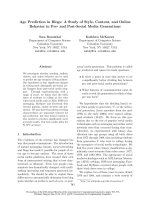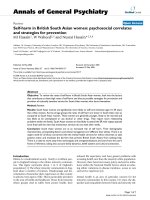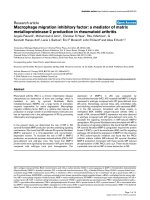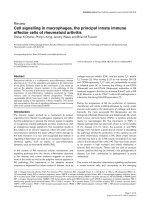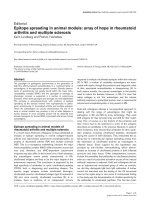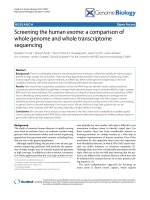Báo cáo y học: "Cell death in sepsis: a matter of how, when, and where" potx
Bạn đang xem bản rút gọn của tài liệu. Xem và tải ngay bản đầy đủ của tài liệu tại đây (47.26 KB, 3 trang )
Available online />Page 1 of 3
(page number not for citation purposes)
Abstract
Dysregulated cell death in several tissues is intimately involved in
the pathogenesis of sepsis and contributes to multiple organ
failure. Whether cell death during sepsis occurs by necrosis or
apoptosis may depend on the cell type as well as the disease
stage and is therefore a matter of intense debate. While lympho-
cyte apoptosis contributes to immunosuppression in sepsis, recent
evidence suggests that necrosis of hepatocytes predominates in
septic patients with liver dysfunction and correlates with poor
survival. These distinct modes of cell death might have different
consequences for the inflammatory response but are also critical
for therapeutic interventions and the disease outcome. Under-
standing the complexity of death processes employing recently
available serum biomarkers of cell death could lead to novel thera-
peutic approaches and assist in the steering of sepsis treatment.
Sepsis is the leading cause of morbidity and mortality in
critically ill patients in many intensive care units. The patho-
physiology of organ failure and death in patients with sepsis
remains elusive. Previously, it was generally thought that
sepsis represented an unbridled immune response with
excessive cytokine production. The failure of almost all anti-
inflammatory agents to improve survival and the finding that
the initial hyper-inflammatory response in sepsis is quickly
followed by an immunocompromised state have considerably
challenged this concept. Increasing evidence now suggests
that extensive apoptotic death results in immune cell
depletion and may compromise the ability of the patient to
eradicate infections. Consequently, there is great hope that
novel therapeutic approaches, including pharmacological
agents that block apoptosis, will prove to be beneficial in
sepsis treatment.
A study published in the previous issue of Critical Care,
however, suggests that a general role of apoptosis in sepsis
might be overestimated and that in other cell types or disease
stages necrosis predominates [1]. Hofer and colleagues
evaluated the use of two novel non-invasive biomarkers of cell
death, caspase-cleaved cytokeratin-18 (CK-18) and uncleaved
CK-18, for the prediction of clinical outcome in sepsis.
Caspases, the key enzymes of apoptosis, cleave the inter-
mediate filament protein CK-18 into specific fragments that
are released into circulating blood and can be detected by a
specific enzyme-linked immunosorbent assay (ELISA). Previous
studies have demonstrated that this technique is a very
sensitive biomarker for liver damage [2,3]. Moreover, when
this assay is combined with a second ELISA that detects the
total release of caspase-cleaved and uncleaved CK-18, even
different forms of cell death, such as necrosis and apoptosis,
can be discriminated [4]. Using these serological assays,
Hofer and colleagues [1] found that patients with severe
sepsis revealed higher levels of the cell death markers com-
pared with postoperative patients or healthy individuals. In
addition, serum CK-18 levels were significantly elevated in
patients not surviving sepsis compared with survivors. Further
analysis showed no differences of the biomarkers between
survivors and non-survivors when liver function was retained.
Importantly, however, significantly higher levels of total
CK-18, indicative of necrosis, were observed in the non-
surviving group with decreased liver function. The results
therefore suggest that, unlike apoptosis, hepatocyte necrosis
is an early predictor of disease outcome in septic patients
with liver dysfunction.
The relative contribution of apoptosis or necrosis to organ
dysfunction in sepsis and most other diseases is unknown
[5]. Necrosis is typically the consequence of acute metabolic
perturbation with ATP depletion as it occurs in ischemia/
reperfusion and acute liver failure. Apoptosis, in contrast,
represents the execution of an ATP-dependent death pro-
gram that is often initiated by death receptor ligation, leading
Commentary
Cell death in sepsis: a matter of how, when, and where
Heike Bantel
1
and Klaus Schulze-Osthoff
2
1
Clinic of Gastroenterology, Hepatology and Endocrinology, Hannover Medical School, Carl-Neuberg-Strasse 1, D-30625 Hannover, Germany
2
Interfaculty Institute for Biochemistry, University of Tübingen, Hoppe-Seyler-Str. 4, D-72076 Tübingen, Germany
Corresponding author: Heike Bantel,
Published: 31 July 2009 Critical Care 2009, 13:173 (doi:10.1186/cc7966)
This article is online at />© 2009 BioMed Central Ltd
See related research by Hofer et al., />CK-18 = cytokeratin-18; ELISA = enzyme-linked immunosorbent assay; IFN-γ = interferon-gamma; IL = interleukin; PARP = poly(ADP-ribose) poly-
merase.
Critical Care Vol 13 No 4 Bantel and Schulze-Osthoff
Page 2 of 3
(page number not for citation purposes)
to a caspase activation cascade [6]. Another important
distinguishing feature of apoptotic versus necrotic cell death
relates to inflammation. When the necrotic cell ruptures, an
intense inflammatory response follows, owing to the release
of intracellular contents. In contrast, inflammation is not
typical of apoptosis, because phagocytic cells rapidly engulf
apoptotic cells and thereby prevent the release of noxious
intracellular compounds. Although apoptosis and necrosis
have been considered distinct and independent phenomena,
the two modes of cell death frequently coexist in different
pathologies. A more extreme injury results in necrotic killing,
whereas a milder injury triggers apoptosis. Understanding the
processes leading to either apoptosis or necrosis is impor-
tant for the development of effective interventions to prevent
organ failure in sepsis.
During sepsis, there is extensive apoptotic death of lympho-
cytes and gastrointestinal epithelial cells [7]. The increased
apoptotic death of lymphocytes is likely to be an important
cause of the profound immunosuppression that is a hallmark
of patients with sepsis. It has been suggested that apoptosis
contributes to immunosuppression in prolonged sepsis in at
least two major fashions: the elimination of key effector cells
and, alternatively, the capacity of apoptotic cells to induce
anergy and a shift to a Th
2
-cell response. Furthermore,
apoptosis of gastrointestinal epithelial cells may compromise
the integrity of the bowel wall, resulting in the translocation of
bacteria or endotoxins into the systemic circulation. A contri-
bution of apoptosis in sepsis is strongly supported by
analysis of postmortem biopsies of septic patients, which
revealed extensive apoptosis of lymphocytes and gastro-
intestinal epithelial cells [8].
The potential importance of apoptosis in the pathogenesis of
sepsis is also illustrated by results from animal models that
demonstrate that blocking lymphocyte apoptosis using
caspase inhibitors improves survival in sepsis [7]. Neverthe-
less, these promising findings must be tempered by the new
study showing that multiple pathways might be activated in
dying cells during sepsis [1]. The simple inhibition of a
particular cell death route therefore might not result in survival
but rather lead to alternative pathways of cell death. Indeed,
apoptosis may even be protective, by obviating the potential
of injured cells to necrosis and further propagating the
inflammatory response. In addition, a recent study indicated
that inhibition of caspases could trigger a hyper-acute tumor
necrosis factor (TNF)-induced shock in certain situations and
actually exacerbate liver injury [9].
In addition to apoptosis, certain caspases, such as caspase-1,
are involved in cytokine maturation by proteolytically proces-
sing the inactive precursors of interleukin (IL)-1β and IL-18,
also known as interferon-gamma (IFN-γ)-inducing factor, to
the active cytokines. There are several independent obser-
vations that the generation of cytokines by proinflammatory
caspases is indeed required for survival in sepsis [10]. In
support of this hypothesis, recombinant IFN-γ does not impair
sepsis survival in clinical trials but seems to improve it [11].
Inhibition of caspases therefore could further dampen the
immune response and exacerbate immunosuppression. Thus,
despite some encouraging results in animal studies, there are
potential pitfalls that could preclude the simple use of
caspase inhibitors for sepsis treatment.
The finding by Hofer and colleagues [1] that necrosis but not
apoptosis is the primary mode of hepatocyte death further
argues against a therapeutic efficacy of caspase inhibitors, at
least in septic patients with liver dysfunction. Focal necrosis
in hepatocytes in the central vein region has previously been
detected in autopsies of septic patients [8]. The hepatocyte
necrosis is presumably caused by hypoxia, mitochondrial
dysfunction, and decreased ATP levels. In line with this, Hofer
and colleagues [1] show that the increased necrosis
correlates with high lactate levels that are characteristic for
acute liver failure. It is interesting to note that high-mobility-
group box protein-1 (HMGB1), which is specifically released
from necrotic but not apoptotic cells, is systemically elevated
in human sepsis and functions as a mediator of endotoxin
lethality in mice [12].
Intense research has recently delineated the signaling path-
way of necrotic cell death. Necrosis has long been con-
sidered an uncontrolled mode of cell death, but it has
become clear that necrosis is a regulated event controlled by
several enzymes such as the serine/threonine kinase RIP1
and the DNA repair enzyme poly(ADP-ribose) polymerase
(PARP) [13]. Necrosis is often associated with mitochondrial
dysfunction, oxidative stress, and disturbance of calcium
homeostasis. Consequently, there are many potential
approaches to pharmacologically modulate necrosis, includ-
ing inhibition of the formation of reactive oxygen species or
inhibition of the influx of extracellular calcium. Moreover,
septic mice that are deficient in PARP have improved survival,
and administration of a PARP inhibitor is beneficial in animal
models [14]. Finally, recently designed inhibitors of RIP1,
called necrostatins, represent new cytoprotective agents that
might impair necrotic tissue damage in sepsis [15]. Certainly,
further work is needed to evaluate future approaches for
modulating cell death in clinical applications of sepsis
treatment.
Competing interests
The authors declare that they have no competing interests.
References
1. Hofer S, Brenner T, Bopp C, Steppan J, Lichtenstern C, Weitz J,
Bruckner T, Martin E, Hoffmann U, Weigand MA: Cell death
serum biomarkers are early predictors for survival in severe
septic patients with hepatic dysfunction. Crit Care 2009, 13:
R93.
2. Bantel H, Lügering A, Heidemann J, Volkmann X, Poremba C,
Strassburg CP, Manns MP, Schulze-Osthoff K: Detection of
apoptotic caspase activation in sera from patients with
chronic HCV infection is associated with fibrotic liver injury.
Hepatology 2004, 40:1078-1087.
3. Seidel N, Volkmann X, Länger F, Flemming P, Manns MP,
Schulze-Osthoff K, Bantel H: The extent of liver steatosis in
chronic hepatitis C virus infection is mirrored by caspase
activity in serum. Hepatology 2005, 42:113-120.
4. Volkmann X, Anstaett M, Hadem J, Stiefel P, Bahr MJ, Lehner F,
Manns MP, Schulze-Osthoff K, Bantel H: Caspase activation is
associated with spontaneous recovery from acute liver failure.
Hepatology 2008, 47:1624-1633.
5. Fischer U, Schulze-Osthoff K: New approaches and therapeu-
tics targeting apoptosis in disease. Pharmacol Rev 2005, 57:
187-215.
6. Leist M, Jäättelä M: Four deaths and a funeral: from caspases
to alternative mechanisms. Nat Rev Mol Cell Biol 2001, 2:589-
598.
7. Hotchkiss RS, Nicholson DW: Apoptosis and caspases regu-
late death and inflammation in sepsis. Nat Rev Immunol 2006,
6:813-822.
8. Hotchkiss RS, Swanson PE, Freeman BD, Tinsley KW, Cobb JP,
Matuschak GM, Buchman TG, Karl IE: Apoptotic cell death in
patients with sepsis, shock, and multiple organ dysfunction.
Crit Care Med 1999, 27:1230-1251.
9. Cauwels A, Janssen B, Waeytens A, Cuvelier C, Brouckaert P:
Caspase inhibition causes hyperacute tumor necrosis factor-
induced shock via oxidative stress and phospholipase A2. Nat
Immunol 2003, 4:387-393.
10. Scott AM, Saleh M: The inflammatory caspases: guardians
against infections and sepsis. Cell Death Differ 2007, 14:23-
31.
11. Döcke WD, Randow F, Syrbe U, Krausch D, Asadullah K, Reinke
P, Volk HD, Kox W: Monocyte deactivation in septic patients:
restoration by IFN-gamma treatment. Nat Med 1997, 3:678-
681.
12. Fink MP: Bench-to-bedside review: high-mobility group box 1
and critical illness. Crit Care 2007, 11:229.
13. Hitomi J, Christofferson DE, Ng A, Yao J, Degterev A, Xavier RJ,
Yuan J: Identification of a molecular signaling network that
regulates a cellular necrotic cell death pathway. Cell 2008,
135:1311-1323.
14. Soriano FG, Liaudet L, Szabó E, Virág L, Mabley JG, Pacher P,
Szabó C: Resistance to acute septic peritonitis in poly(ADP-
ribose) polymerase-1-deficient mice. Shock 2002, 17:286-
292.
15. Vandenabeele P, Declercq W, Berghe TV: Necrotic cell death
and ‘necrostatins’: now we can control cellular explosion.
Trends Biochem Sci 2008, 33:352-355.
Available online />Page 3 of 3
(page number not for citation purposes)
